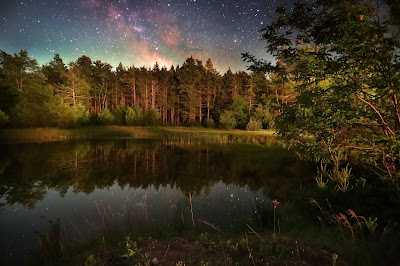Comet C/2023 A3 (Tsuchinshan–ATLAS) is making its grand journey through the inner solar system, inspiring astronomers, photographers, and stargazers around the world. As part of this collective fascination, I’m excited to share my photographs I captured of this remarkable celestial visitor against the vibrant cityscape of Brooklyn, NYC.
These photos are my small contribution to the ongoing global observation of this rare comet, offering a glimpse into how even from an urban environment, the wonders of space remain accessible to those with the patience to seek them.
%20visible%20from%20Brooklyn%20over%20the%20Verrazano%20Bridge%20and%20Staten%20Island%20after%20Sunset.jpg) |
| Comet C/2023 A3 (Tsuchinshan–ATLAS) visible from Brooklyn over the Verrazano Bridge and Staten Island after Sunset |
Canon EOS Ra, EF16-35mm f/2.8L II USM Lens, f/3.8, ISO 1600, 2 sec. October 15, 2024.
In a stunning blend of cosmic beauty and urban life, Comet C/2023 A3 (Tsuchinshan–ATLAS) was captured over Brooklyn just after sunset. Although not visible to the naked eye due to the intense light pollution of New York City, the comet revealed itself through the preview on a Canon RA camera.
 |
| Comet C/2023 A3 (Tsuchinshan–ATLAS) over Brooklyn, NYC. |
Canon EOS Ra, EF16-35mm f/2.8L II USM Lens, f/3.2, ISO 400, 3 sec. October 15, 2024.
Nestled between Staten Island and a boat drifting across the water, the comet adds a subtle glow beneath the iconic Verrazano Bridge, demonstrating the magic that can still be found in the night sky, even amid the city’s overwhelming lights.
The next photo dives deeper into the beauty of Comet C/2023 A3, revealing details not visible in the wide-angle city shot. Captured with a Canon EF 200mm f/2.8L II USM telephoto lens, the image showcases the comet’s bright, glowing tail and even a faint anti-tail.
Canon EOS 60Da, Canon EF200mm f/2.8L II USM Lens, f/2.8, ISO 2500, 2 sec, stock 10 images, using iOptron SkyTracker, October 16, 2024.
The anti-tail is a fascinating feature that forms due to the unique alignment between the comet, the Sun, and Earth. While the main tail streams away from the Sun, the anti-tail appears to extend in the opposite direction. This is not because the comet has two tails going in different directions, but rather due to an optical illusion caused by our perspective. The anti-tail consists of dust particles along the comet’s orbit, which, under the right angle, seem to point sunward.
These images represent not just the beauty of the comet but also the joy of participating in a global observation effort. Whether observing from a dark, rural landscape or amidst the glowing lights of a bustling city, we all have the opportunity to look up and witness the universe unfolding before us.

























































